How to Grow Fiddle-Leaf Fig: From Lighting to Repotting
- March 5, 2024
- 0 comment
The Fiddle-Leaf Fig (Ficus lyrata) has risen to prominence as a favorite indoor plant for its distinctive, violin-shaped leaves and its ability to elevate the aesthetics of living spaces. However, it’s also known for being a bit finicky. This guide provides comprehensive tips to help you grow and nurture your Fiddle-Leaf Fig.
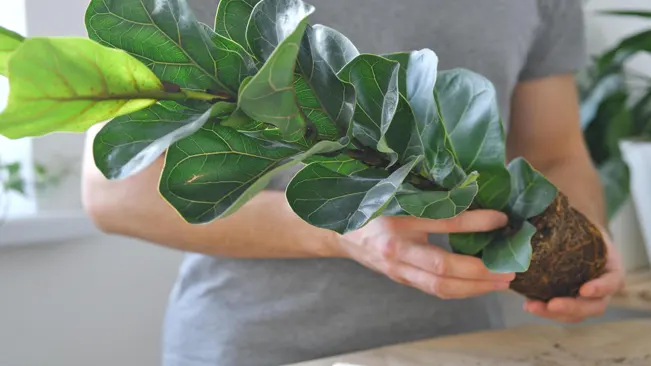
Understanding Your Fiddle-Leaf Fig
Native to the tropical rainforests of West Africa, Fiddle-Leaf Figs thrive in a warm, humid environment with plenty of bright, filtered light. They are known for their large, glossy, and leathery leaves, which can make a dramatic statement in any room.
- Origin and Habitat The Fiddle-Leaf Fig, or Ficus lyrata, is native to the rainforests of West Africa. It thrives in warm, humid conditions with dappled sunlight, shielded from direct sun. These conditions are essential for replicating in indoor care.
- Physical Characteristics This plant is known for its large, violin-shaped leaves, which are glossy, leathery, and dark green. These leaves can grow up to 15 inches long and are efficient in light absorption.
- Growth Habits In the wild, Fiddle-Leaf Figs can reach up to 40 feet. Indoors, they usually grow between 2 to 10 feet tall, with an upright growth habit that adds vertical interest to indoor spaces.
- Adaptability Despite its rainforest origins, the Fiddle-Leaf Fig adapts well to indoor environments. It requires specific conditions similar to its natural habitat to thrive indoors.
- Light Requirements Bright, indirect sunlight is ideal for the Fiddle-Leaf Fig. Direct sun can burn the leaves, while insufficient light can hinder growth and cause leaf drop.
- Significance in Home Decor With its striking appearance, the Fiddle-Leaf Fig is a popular choice in interior design. Its large leaves and tall form add elegance and create a focal point in rooms.
- Emotional and Health Benefits The Fiddle-Leaf Fig not only enhances room aesthetics but also promotes well-being. It’s known for air-purifying qualities and can have a calming effect, making it a rewarding addition to the home.
Optimal Lighting

- Understanding Light Needs The Fiddle-Leaf Fig’s need for bright, indirect light is rooted in its natural habitat. In the rainforest, these plants are accustomed to receiving dappled sunlight filtered through the canopy. This kind of light is bright yet diffused, providing the energy they need without the harshness of direct sun exposure.
- Choosing the Right Spot To replicate these conditions, position your Fiddle-Leaf Fig near a window that receives plenty of natural light throughout the day. East-facing windows are often ideal as they provide bright morning light without the intense heat of the afternoon sun. North-facing windows can also work, but the plant may need to be closer to the window to receive enough light.
- Avoiding Direct Sunlight Direct sunlight, especially during the hot midday or afternoon hours, can be detrimental. It can cause the leaves to scorch, leading to brown spots or a bleached appearance. If your only available window is south-facing, which often receives the most intense light, you may need to use sheer curtains or move the plant back from the window to avoid direct sun exposure.
- Adjusting for Seasons The angle and intensity of sunlight change with the seasons, so you may need to adjust the plant’s position throughout the year. During shorter winter days, when sunlight is less intense, your Fiddle-Leaf Fig might benefit from being closer to the window. Conversely, during the bright summer months, it might need to be further away from direct light sources.
- Artificial Lighting If you’re in a space with limited natural light, consider using grow lights. These artificial lights can provide the spectrum of light needed by the plant. Position the lights to mimic overhead, natural light and use them for 12-14 hours a day to compensate for the lack of natural sunlight.
- Observing Your Plant Finally, observe your Fiddle-Leaf Fig’s response to its lighting conditions. If the leaves start to look faded or scorched, it might be receiving too much direct sunlight. If the plant is leggy, or the leaves are sparse and small, it’s likely not getting enough light. Adjusting its position gradually until you find the right balance is key.
Watering Requirements
Over-watering is a common mistake. Wait until the top inch of soil is dry before watering. In the winter, reduce the frequency as the plant goes into a dormant state. If the leaves start to droop or turn yellow, it may be a sign of over-watering.
- Right Timing The key to watering a Fiddle-Leaf Fig is to wait until the top inch of the soil is dry. This method helps in ensuring that you’re not over-watering the plant. You can check this by simply sticking your finger into the soil. If it’s dry to the touch at about an inch deep, it’s time to water.
- Seasonal Adjustments During different seasons, the Fiddle-Leaf Fig’s water needs will vary. In the winter months, the plant enters a dormant state where its growth slows down. During this period, it requires less water. Conversely, in the growing seasons of spring and summer, the plant will need more frequent watering as it is actively growing and using up more water.
- Signs of Over-Watering Over-watering is one of the most common problems when it comes to caring for Fiddle-Leaf Figs. Signs of over-watering include drooping leaves and yellowing of the leaves. In severe cases, over-watering can lead to root rot, a serious condition that can be fatal to the plant.
- Quality and Quantity of Water When you water your Fiddle-Leaf Fig, ensure that the water reaches the root system. Water should be poured evenly around the soil until it begins to drain out of the bottom of the pot. This ensures the roots are adequately hydrated. The quality of water matters too; it’s best to use room-temperature water, as cold water can shock the plant’s roots.
- Humidity Considerations Fiddle-Leaf Figs, being native to humid environments, benefit from a humid atmosphere. In dryer home environments, consider using a humidifier or misting the leaves regularly to replicate the humidity levels of their natural habitat. This is especially helpful in preventing the edges of the leaves from turning brown, a common issue in drier conditions.
- Potting and Drainage Ensure your Fiddle-Leaf Fig is in a pot with good drainage. This helps to prevent water from sitting at the bottom of the pot, which can lead to root rot. A well-draining potting mix is also crucial for maintaining the right moisture levels in the soil.
Ideal Humidity and Temperature
Fiddle-Leaf Figs love humidity. If you live in a dry area, consider using a humidifier or regularly misting the leaves. Keep the temperature around 65-75 degrees Fahrenheit and avoid placing your plant near air vents or drafty windows.
Ideal Humidity for Fiddle-Leaf Figs
Fiddle-Leaf Figs, being native to tropical rainforests, thrive in humid conditions. The ideal humidity level for these plants is around 60-75%. In environments that are less humid:
- Humidifiers: Using a humidifier near your plant can help maintain the necessary humidity levels, especially in dry climates or during winter when indoor heating can dry out the air.
- Misting: Regularly misting the leaves can also help increase the local humidity around the plant. However, be cautious not to overdo it as excessive moisture on leaves can lead to fungal problems.
- Grouping Plants: Placing your Fiddle-Leaf Fig near other plants can create a microclimate with higher humidity, as plants naturally release water into the air through transpiration.
- Pebble Trays: A tray filled with pebbles and water placed under the plant’s pot can also increase humidity. The water evaporates around the plant, providing a humid microclimate.
Ideal Temperature for Fiddle-Leaf Figs
The temperature range for Fiddle-Leaf Figs to thrive is between 65 and 75 degrees Fahrenheit (18 to 24 degrees Celsius). These plants are sensitive to drastic temperature changes and cold drafts, which can lead to leaf loss and stunted growth:
- Avoid Drafts: Keep your Fiddle-Leaf Fig away from drafty windows and doors, especially during colder months.
- Keep Away from Air Vents: Direct airflow from heating or air conditioning vents can create unfavorable conditions for your plant by reducing humidity and causing temperature fluctuations.
- Consistent Temperature: Try to maintain a consistent temperature in the room where your plant is located. Sudden temperature changes can stress the plant.
Soil and Fertilization
Use a well-draining, peat-based potting soil. During the growing season (spring and summer), fertilize once a month with a balanced, liquid fertilizer. Avoid fertilizing in the winter months.
Soil Requirements
The choice of soil is crucial for the health of a Fiddle-Leaf Fig. This plant thrives in soil that closely mimics its natural habitat in the rainforest, which is rich and well-draining. Here are key aspects to consider:
- Well-Draining: The soil must allow water to pass through easily to prevent waterlogging, which can lead to root rot. Good drainage ensures that the roots get enough oxygen and aren’t sitting in water.
- Peat-Based: Peat-based potting mixes are recommended because they retain moisture while still providing good drainage. This type of soil also tends to be slightly acidic, which is beneficial for Fiddle-Leaf Figs.
- Aeration: The soil should be light and airy to promote root health. You can achieve this by adding perlite or vermiculite to the mix, which will improve the soil’s structure and drainage capabilities.
- Nutrient-Rich: The soil should be rich in nutrients to support the plant’s growth. A good-quality commercial potting mix usually contains the necessary nutrients, but you can also add compost for an extra boost.
Fertilization
Fertilizing your Fiddle-Leaf Fig is essential for its growth and health, particularly during its active growing season.
- Growing Season: This typically includes spring and summer. During these months, the plant is actively growing and can benefit most from additional nutrients.
- Balanced, Liquid Fertilizer: A balanced fertilizer (with an equal ratio of nitrogen, phosphorus, and potassium) is ideal. Liquid fertilizers are preferred because they are easier to control and can be evenly distributed in the soil.
- Monthly Application: Fertilize once a month during the growing season. It’s important not to over-fertilize, as this can lead to salt build-up in the soil and potentially harm the plant.
- Avoid Winter Fertilization: In winter, the Fiddle-Leaf Fig’s growth slows down, and it enters a dormant phase. Fertilizing during this time can do more harm than good, as the plant isn’t actively using the nutrients provided.
Pruning and Cleaning
To encourage growth and maintain shape, prune your Fiddle-Leaf Fig in the spring. Use sharp, clean shears to cut back any overgrown branches. Wipe the leaves regularly with a damp cloth to remove dust.
- Choosing the Right Time: Spring is ideal because the plant is exiting its dormant winter phase and is ready to grow.
- Tools: Use sharp, clean shears. This ensures clean cuts and reduces the risk of infection to the plant.
- Technique: When pruning, aim to remove any overgrown branches that disrupt the plant’s shape. You can also trim any damaged or dead leaves and branches, which helps redirect the plant’s energy to healthier growth.
- Moderation: Avoid over-pruning, as removing too much foliage can stress the plant. A good rule of thumb is not to remove more than 10-15% of the foliage at once.
Cleaning for Health and Shine
Regular cleaning of the leaves is equally important. Fiddle-Leaf Fig leaves are large and can accumulate dust, which can hinder photosynthesis and affect the plant’s health. Here’s how to clean them properly:

- Frequency: Wipe the leaves every few weeks or as needed when you notice dust accumulation.
- Method: Use a soft, damp cloth to gently wipe each leaf. Support the leaf with one hand while cleaning with the other to avoid damaging it.
- Water Temperature: Use lukewarm water, as cold water can shock the plant.
- Avoid Chemicals: It’s best to avoid using leaf shine products or chemicals, as these can clog the leaf pores.
Benefits of Pruning and Cleaning
- Improved Growth: Pruning encourages new growth and can help the plant become fuller and more robust.
- Disease Prevention: Regular cleaning and pruning help prevent disease and pest infestations by removing potential breeding grounds.
- Aesthetic Appeal: Clean and well-pruned Fiddle-Leaf Figs are more visually appealing, making them a stunning addition to any space.
Repotting
Why Repotting is Important
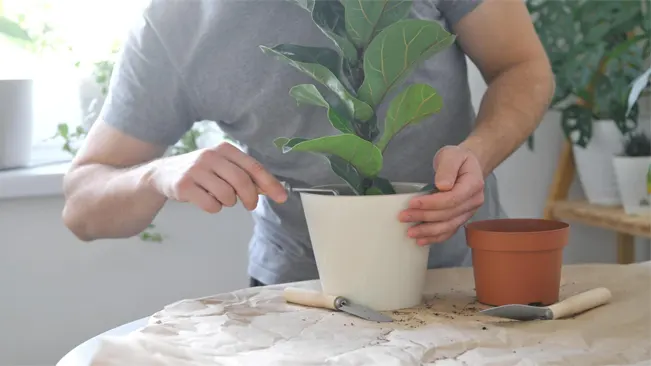
- Root Growth and Health: Over time, Fiddle-Leaf Figs outgrow their pots. Their roots need more space to expand. Without repotting, the plant can become root-bound, where the roots circle tightly inside the pot, hindering growth and health.
- Soil Refreshment: Repotting gives you an opportunity to refresh the soil, which depletes of nutrients over time. Fresh soil means better nutrient availability for the plant.
Choosing the Right Pot
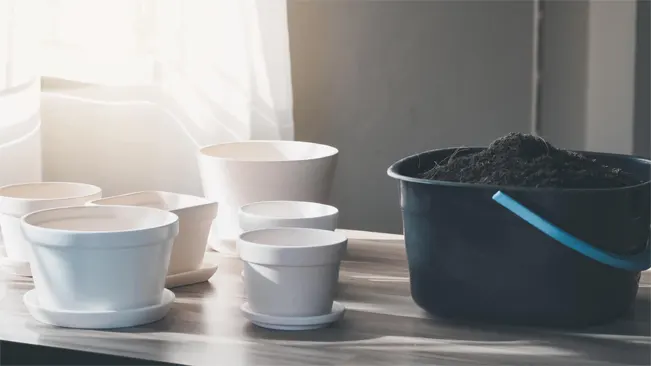
- Size: Select a pot that is 2-3 inches larger in diameter than the current one. This size increment is enough to give the roots room to grow without being overwhelming.
- Material: Pots made of breathable materials like terracotta are beneficial as they allow excess moisture to evaporate, reducing the risk of root rot.
- Drainage: Ensure the new pot has adequate drainage holes. Good drainage is crucial to prevent waterlogging, which can lead to root rot.
Best Time to Repot
- Growth Season: The best time to repot is during the growing season, typically in spring. This timing allows the plant to recover and grow into its new space.
- Signs to Watch For: Indications that your Fiddle-Leaf Fig needs repotting include roots growing out of the drainage holes, slowed growth, or the soil drying out more quickly than usual.
Repotting Process
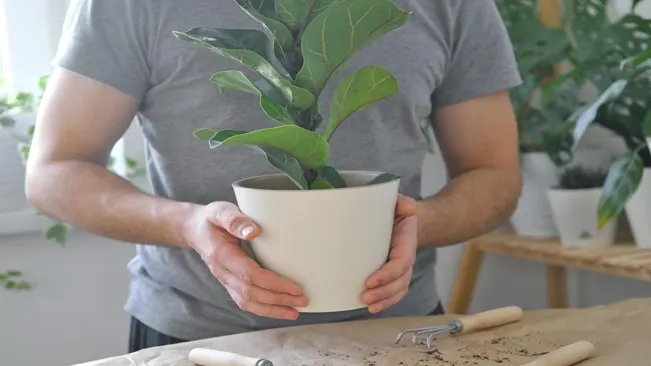
- Preparation: Water your plant a day before repotting to make the process less stressful for the plant.
- Removing the Plant: Gently remove the plant from its current pot. Be careful not to damage the roots.
- Root Inspection: Trim any excessively long or circling roots. Look for signs of rot or disease and remove affected parts.
- New Pot and Soil: Place a layer of fresh potting soil in the new pot. Use well-draining soil that’s suitable for Fiddle-Leaf Figs.
- Repotting: Position the plant in the center of the new pot and fill around the roots with more soil. Tap the pot gently to settle the soil.
- Aftercare: Water the plant lightly after repotting. Avoid fertilizing immediately after repotting to allow the roots to settle.
Post-Repotting Care
- Light and Water: Keep the plant in indirect light and maintain regular watering, allowing the top inch of soil to dry out between waterings.
- Observation: Monitor your plant for signs of stress or shock, which can include leaf drop or wilting. These are normal and should resolve as the plant adjusts to its new pot.
Common Problems
Watch out for pests like spider mites and mealybugs. Isolate the plant and treat it with neem oil or insecticidal soap. Brown spots on leaves may indicate root rot from over-watering.
Conclusion
Caring for a Fiddle-Leaf Fig may require a bit of trial and error, but the results are worth it. With proper care, your Fiddle-Leaf Fig will grow into a stunning, leafy centerpiece that brings a touch of nature into your home.
FAQs (Frequently Asked Questions)
- What is the best light for a Fiddle-Leaf Fig?
Fiddle-Leaf Figs thrive in bright, indirect sunlight. Direct sunlight can burn the leaves, while too little light can stunt growth and cause leaf drop. - How often should I water my Fiddle-Leaf Fig?
Water when the top inch of the soil feels dry, typically every 7-10 days, but this can vary based on the environment. It’s crucial not to over-water, as this can lead to root rot. - Do Fiddle-Leaf Figs need a specific type of soil?
They prefer well-draining, fertile soil. A mix of potting soil with peat and perlite is ideal, as it ensures adequate drainage and aeration. - Should I fertilize my Fiddle-Leaf Fig, and how often?
Yes, fertilize with a balanced, water-soluble fertilizer during the growing season (spring and summer), approximately once a month. Reduce fertilization in fall and winter. - How do I know if my Fiddle-Leaf Fig is getting too much light?
If the leaves start to show signs of scorching, such as browning or crisp edges, it may be receiving too much direct sunlight. - Can I prune my Fiddle-Leaf Fig, and how should I do it? Yes, pruning helps to shape the plant and encourage fuller growth. Prune in the spring by cutting just above a leaf node. Always use clean, sharp pruning shears.
- What temperature is ideal for a Fiddle-Leaf Fig?
They prefer temperatures between 60-75°F (15-24°C). Avoid placing your plant near drafts or heat sources, as sudden temperature changes can stress the plant. - How do I deal with pests on my Fiddle-Leaf Fig?
Common pests include spider mites, mealybugs, and aphids. Treat infestations with insecticidal soap or neem oil, and keep the leaves clean to prevent pests. - Why are the leaves of my Fiddle-Leaf Fig turning yellow?
Yellow leaves can be a sign of over-watering, poor drainage, or a nutrient deficiency. Check the soil and watering schedule, and consider repotting if the problem persists. - How often should I repot my Fiddle-Leaf Fig?
Typically, repotting every 1-2 years is recommended, or when the plant becomes root-bound. Choose a pot that’s slightly larger than the current one and refresh the soil to provide new nutrients.

Kristine Moore
Forestry AuthorI'm Kristine Moore, a seasoned garden landscaping professional with over 30 years of experience. My extensive career has been dedicated to transforming outdoor spaces into stunning, sustainable landscapes. With a deep understanding of horticulture, design principles, and environmental stewardship, I have become a respected figure in the field, known for creating harmonious, visually appealing, and eco-friendly gardens. My commitment to excellence and continuous learning in landscaping trends and techniques has solidified my reputation as an expert in garden design and implementation.









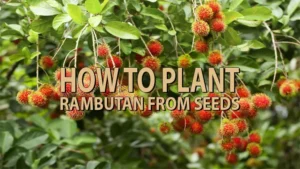



Leave your comment